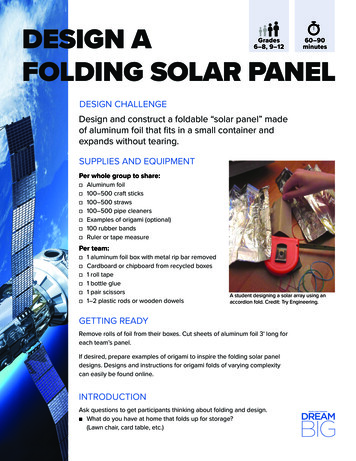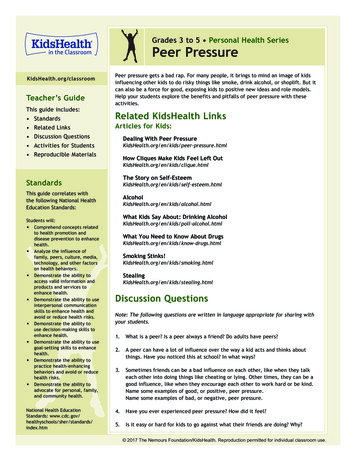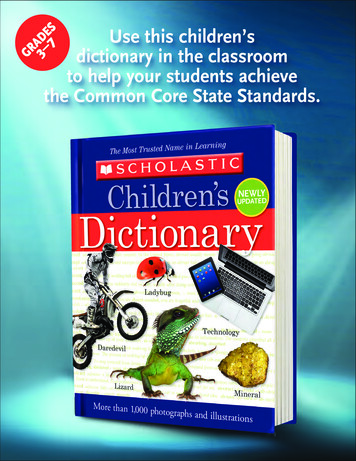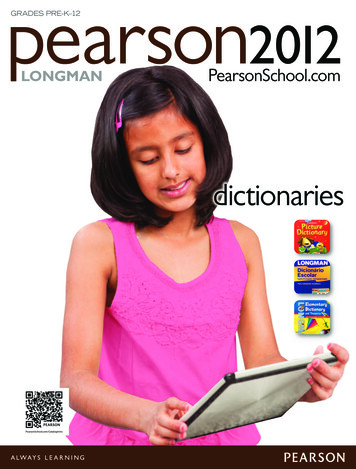
Transcription
DESIGN AFOLDING SOLAR PANELGrades6–8, 9–1260–90minutesDESIGN CHALLENGEDesign and construct a foldable “solar panel” madeof aluminum foil that fits in a small container andexpands without tearing.SUPPLIES AND EQUIPMENTPer whole group to share: Aluminum foil100–500 craft sticks100–500 straws100–500 pipe cleanersExamples of origami (optional)100 rubber bandsRuler or tape measurePer team: 1 aluminum foil box with metal rip bar removedCardboard or chipboard from recycled boxes1 roll tape1 bottle glue1 pair scissors1–2 plastic rods or wooden dowelsA student designing a solar array using anaccordion fold. Credit: Try Engineering.GETTING READYRemove rolls of foil from their boxes. Cut sheets of aluminum foil 3' long foreach team’s panel.If desired, prepare examples of origami to inspire the folding solar paneldesigns. Designs and instructions for origami folds of varying complexitycan easily be found online.INTRODUCTIONAsk questions to get participants thinking about folding and design. What do you have at home that folds up for storage?(Lawn chair, card table, etc.)
INTRODUCTION (CONTINUED) Folding laundry is a chore that some people don’t like. Why do we do it?(So our clothes fit in drawers and don’t wrinkle.)The large solar arrays on the International Space Station are 115 feet longby 38 feet wide. The James Webb Space Telescope (scheduled to launchin October 2018) is the size of a tennis court. Both of these are far too largeto send into orbit without making them smaller, so they must be folded tofit. Engineers must plan how these devices will fold up to fit in the rocketand how they will unfold once they are in space. Engineers address thisand many other challenges when working with objects destined for space.INSTRUCTIONSGet participants thinking about how much space objects take up and howthey could be folded to be smaller. For example, show origami creations aswell as the paper from which they were made.Introduce the design challenge. Participants will work in teams of 3–4 todesign a folding aluminum foil “solar panel” that fits in an aluminum foilpackaging box and can open to its full dimensions without tearing. Givethem the following constraints: The unfolded dimensions of the solar panel must be as close to 1' x 3'as possible. The solar panel must be taped to the bottom of the box. The solar panel can only be touched by one hand when unfolding. Optional: The solar panel must rigidly keep its unfolded shape withoutbeing held by a person.Give the participants 5–10 minutes to brainstorm their designs. Suggestthat they keep origami in mind; engineers take inspiration from the work ofothers to create a design that fits their needs. Encourage them to makedrawings or small-scale models to help communicate their ideas. Eachteam must decide on a final design as a group, as well as the materialsthey will use.Give the groups 20–40 minutes to build their designs. Check in with each team during the build time. If teams are frustrated,give them a hint but avoid building anything for them.Give each team a chance to show off their design to the rest of the groupby asking them to present on the following points: Demonstrate the solar panel’s operation. Share inspiration and difficulties. Explain whether working on a team made the solar panel moresuccessful, and how they think engineers work in teams.Design a Folding Solar Panel2
INSTRUCTIONS (CONTINUED)Evaluate the success of each design. Was the solar panel able to fit into the box? Did the solar panel extend to 1' x 3' without tearing? Was the solar panel able to be unfolded with one hand?ACTIVITY VARIATIONSMake the design challenge more difficult by using tissue paper instead of foil.RELEVANT TERMINOLOGYElectricity: A form of energy caused by the flow of electrons that occursnaturally and can be transferred through conductive materials likewires.Solar array: Another name for solar panel; made of solar cells thatconvert light energy or photons into electrical energy through thephotovoltaic effect.Working on the port overhead solar array wing of the International Space Station. Credit: NASA.Design a Folding Solar Panel3
GUIDANCE FOR YOUNGER CHILDRENQUESTIONS TO ASK AFTER THE ACTIVITYWhat were you looking for when selecting materials for yoursolar panel? What did you learn by testing your solar panel after designing it? After testing your solar panel, did you make any changes to yourdesign? (Explain that engineers test and retest designs and are alwayslooking to make things better.) What examples or ideas did you consider when designing and foldingyour solar panel? ENGINEERING CONNECTIONSMechanical engineering is a field of engineering that requires knowledge ofengineering, physics, and different materials to create machines or parts for them.And sometimes engineers need to know about art, as well! For example, BrianTrease, a mechanical engineer at NASA, designed solar panels based on theJapanese art of folding paper called origami. Solar panels used in space alreadywere designed to fold up, but Brian believes that by folding solar panels like paperis folded in origami, it’s easier to get these panels into space.One type of origami fold that he uses is called the Miura fold. This allows the panelto be folded and fit into a small space while being carried into space, but thenopened into a big checkerboard that can catch the sun and power the satellite.The Miura fold also makes the launch of a solar panel easier because there is onlyone way to open or close it: pull on one corner. Brian used the Miura fold todesign a solar panel prototype that looks like a blooming flower and, whenopened, forms a big, flat, circular surface to catch sunlight and generate electricity.SCIENCE CONNECTIONSPlants use the energy in sunlight to create their own food in a process calledphotosynthesis. Solar power is generated through a similar process. Energy insunlight is converted into electricity using solar panels, which are also calledphotovoltaic cells. These solar panels are a necessary part of every satellite inorbit. However, they are far too big to launch on a rocket without folding them upin some way.Folding is an important feature of human-made and natural structures. Naturefolds objects to fit them into a small space. For example, a butterfly’s wings arefolded until it hatches from its chrysalis. Petals fold inside a flower bud. Productslike bicycles and chairs can be designed to fold for storage in small spaces.Folding bridges allow cars and boats to share waterways. Folding stents that areinserted into veins and arteries allow doctors to treat weakened blood vessels.Even DNA is folded. The DNA in a single cell of your body is six feet long!However, because it is folded by special proteins, it can fit into a microscopic cell.Folding is one way to make efficient use of space.Design a Folding Solar Panel4
GUIDANCE FOR OLDER YOUTHAND ADULTSQUESTIONS TO ASK AFTER THE ACTIVITY Why is it so important for solar panels to be foldable when goinginto space? How did you go about selecting materials for designing your foldingsolar panel? After testing your prototype, what refinements did you make toyour design? What designs did you use as inspiration when folding your solar panel?ENGINEERING CONNECTIONSTo deliver payloads (cargo and satellites) during the Space Shuttle program years,a device called the Canadarm was used. This series of robotic arms was built intoeach shuttle cargo bay and was used to load, unload, capture, and move cargoand satellites when in orbit. In order for the shuttle to both take off and land, thearm needed to fit into the cargo bay along with the payload so that the cargodoors could close. To accomplish this, NASA engineers designed the Canadarm tobe 50 feet long with six joints that are similar to a shoulder, elbows, wrists,and fingers.SCIENCE CONNECTIONSFor engineers to design objects that can be folded up to fit into constrainedspaces, they need a strong understanding of the mathematics of shapes. Thisarea of study is called geometry. The most basic shapes in that field that mosteveryone knows about are ones like squares, rectangles, circles, and triangles.However, those are all known as two-dimensional shapes.When folding objects to fit into three-dimensional spaces such as a rocket’s cargobay, engineers must be able to understand how their two-dimensional shapes canbe attached to one another and then folded or unfolded to form three-dimensionalshapes. This can be very complex and often requires the assistance of computers.Basic three-dimensional shapes include spheres (like a ball), cylinders (like a soupcan), and cones (like a birthday hat). However, NASA engineers are likely to dealwith much more complex shapes that go by names like oblate spheroid, truncatedtetrahedron, and disphenoid. No matter the name, geometry is a necessary field ofstudy for engineers wishing to fit big objects into small spaces!Design a Folding Solar Panel5
ENGINEERING OUR WORLDdreambigfilm.comACKNOWLEDGMENTSActivity courtesy of IEEE TryEngineering.orgAll rights iles/lessons/folding.pdfSupplemental content adapted for Dream BigActivities by the Carnegie Science Center.Find more great activities at DiscoverE.orgDesign a Folding Solar Panel6
The solar panel can only be touched by one hand when unfolding. Optional: The solar panel must rigidly keep its unfolded shape without being held by a person. Give the participants 5–10 minutes to brainstorm their designs. Suggest that they keep origami in mind; engineers take inspiration from the work of others to create a design that fits their needs. Encourage them to make drawings or .











